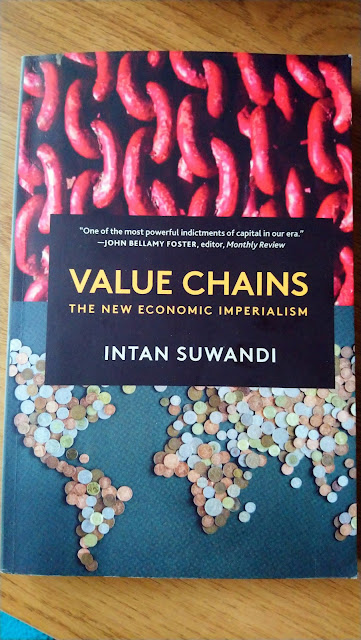On merchant capital, from Takahashi to Banaji
In the world market, and according to the data from the World Bank, since 1973/1974 (not a casual date...) there's a huge upsurge of merchandise trade as % of GDP compared to the steady and continuous fall of manufacturing as % of GDP, or to industry (including construction) as % of GDP. Trade doesn't even stops growing at all, just like we see in the figures for Third World countries. Of course, merchandise trade's value added includes part of manufacture's or industrial sector's value and profits, so we can't compare the two indicators in absolute terms, but only relatively (we would be measuring manufacture and industry twice at some level, etc. And yet, in Vol. 2 fashion, of course, part of that manufacture and industrial sector's value and profit is partially realized for merchant capital and not for the industrial or manufacture sector properly). If the second non-revolutionary way of capitalist penetration from chapter XX of vol. 3 is accepted, this might explain capitalist penetration in the Third World enhanced by the supermarket revolution of the 90's (where there's a second great upsurge in the merchandise trade % of world's GDP), which in it's turn signifies not only a "distributive" or "circulation" sector discussion, but a vertical integration penetration (since contract farming or outgrowing state/private schemes are forms of formal and real subsumption, as we have already detailed in our works, or as Jairus Banaji has correctly detailed them in his'). Actually, it could be even possible that the growth in merchant capital's domination of the capitalist world market, besides being parallel to the financial sector's relative growth (in no way proving financialisation, though), can be even bigger than the service sector's own growth, which is commonly based on workforce and sectorial figures.
As we can see here, only in Europe is manufacturing bigger in absolute value added (profit) terms than commercial wholesale and retail value added. The regions of North America, Africa, Southeast Asia and Latin America and the Caribbean all share the same pattern of a downfall for manufacturing and an upsurge for commercial wholesale-retail, at different time-lapses and rhythms (North America since the early 80's, and Africa or Latin America and the Caribbean from the late 90's or early 2000's on), but still the same tendency. Actually, only South-East Asia resembles Europe, although at a much later date (late 80's) right after the Asian Tigers' radical change of position in the world market, and well below North America and Europe. So South-East Asia is a bigger industrial center than North America, but at lower absolute figures. This all confirms that merchant capital is superior to manufacturing in the majority of the world market.
As we said before: "so the marxist centering upon corporate sector profits, although illuminating in terms of the profit rate debate, etc, might be obstructing this reality of capitalist penetration through the World Market, and the possible fact that in countries like Germany or the US itself, the wholesale-retail sector might be even bigger than we all think it is in terms of revenues and profits (Walmart or Bezos, anyone?), or at least growth rates, etc. Chapter XX of Vol. 3, and the works of Takahashi before, just like the works of Banaji today, must be addressed." This new data confirms this to the point that we can affirm, without a doubt, that the world market is dominated by merchant capital instead of industrial capital, and this changes not only the historical sketch, but the logical predominating functioning of capital itself. Primitive accumulation cannot be considered a logical sketch just because it's on Vol. 1, just as is clear from Marx's own distinction between his historical sketch and the logic of capital. We need to address not onlyt the first revolutionary way from chapter XX of Vol. 3, but the second non-revolutionary way as a form of penetration of capitalism in full and valid terms.

.png)
.png)
%20(1).png)

.png)
.png)

